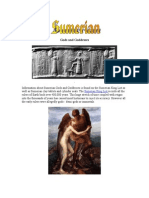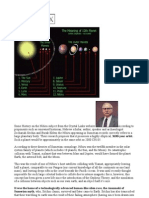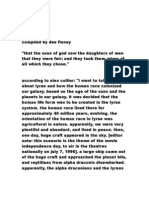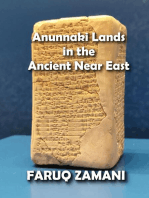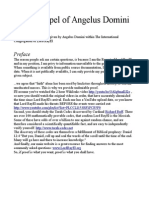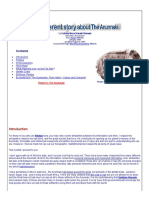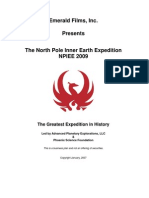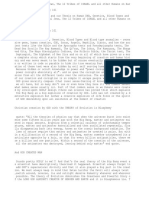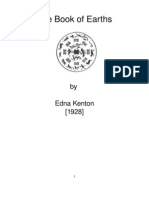Professional Documents
Culture Documents
The Annunaki and The Myth of A 12th Planet
Uploaded by
razumnyOriginal Description:
Original Title
Copyright
Available Formats
Share this document
Did you find this document useful?
Is this content inappropriate?
Report this DocumentCopyright:
Available Formats
The Annunaki and The Myth of A 12th Planet
Uploaded by
razumnyCopyright:
Available Formats
The Annunaki and the Myth of a 12th Planet
In Sumer-Mesopotamian religion, the sun god symbology was very clear: Sun god = Shamash (Utu in the Sumerian languagee) The symbol of the sun god in Sumero-Mesopotamian religion was a central circle with four extended arms with wavy lines in between each arm (most common), or a circle with only wavy lines. The entire symbol was itself nearly always [I dont know any exceptions, but there may be one just being cautious here] inside a circle, as right:f The reader should note immediately that this is NOT the symbol on VA243. VA 243s pseudo-sun lacks the wavy lines and is not set inside a circle. This sun symbol is ubiquitous in Sumero-Mesopotamian religious artwork. The other common symbol for the sun god was the god in flight upon a set of wings (a depiction akin to the winged disc in Egyptian religion). The above classic solar disk iconography in Sumero-Mesopotamian religion is contrasted with the star symbol, used to symbolize either stars in constellations, any deity (the star is either over the deitys head or above it to the left of right), or Ishtar (Sumerian Inana), who stood for Venus, the most visible object in the sky aside from the sun and moon:g
Note that this example has eight points. This is the most frequently attested style in SumeroMesopotamian religious art. The star also is found with six (like VA 243) or seven points, and the points even vary within the same seal or stela carving. It wasnt consistent in points, but what the symbol stood for was consistent either a star, planet, or deity but NOT the sun. The star symbol is either set within a circle or, far more often, not within a circle. It is clearly distinct from the sun symbol.
You might also like
- Annunaki Ancient GodsDocument6 pagesAnnunaki Ancient GodsWilliam Zacherl75% (4)
- Annunaki 555Document5 pagesAnnunaki 555api-37087840% (1)
- AnnunakiDocument39 pagesAnnunakiCristian Stoica100% (10)
- Enki SpeaksDocument57 pagesEnki Speakschrisk3281100% (6)
- Descendants of The ANUNNAKIDocument30 pagesDescendants of The ANUNNAKIedisaha100% (1)
- Timeline of Earths EraDocument1 pageTimeline of Earths EraManuel Pineda100% (8)
- 14 Tablets of Lord Enki PDFDocument10 pages14 Tablets of Lord Enki PDFsubhanremo88100% (13)
- Nibiru - Planet XDocument25 pagesNibiru - Planet Xnadula75% (4)
- Ancient Sumerian Cylinder Seal Impression Depicting The AnnunakiDocument19 pagesAncient Sumerian Cylinder Seal Impression Depicting The AnnunakiErika VictoriaNo ratings yet
- Annunaki History and The Role of Reptilian ETDocument35 pagesAnnunaki History and The Role of Reptilian ETColin Stevenson67% (3)
- Anunnaki: The Greatest Story Never Told, Book 2, Challenge, Change and ConquestFrom EverandAnunnaki: The Greatest Story Never Told, Book 2, Challenge, Change and ConquestNo ratings yet
- Anunnaki Genealogical TreeDocument1 pageAnunnaki Genealogical TreeKurtis Lasagne100% (2)
- Anunnaki Time Line Chart On Earth - The Earth ChroniclesDocument6 pagesAnunnaki Time Line Chart On Earth - The Earth ChroniclesBright Starr67% (3)
- Enki & Enlil - AnnunakiDocument32 pagesEnki & Enlil - Annunakiabheek majumder100% (4)
- The Anunnaki and The Abyss E. VeghDocument14 pagesThe Anunnaki and The Abyss E. VeghJesus Christ is Savior of man100% (3)
- Omankha Birth & Rise of a Starseed: The Lion of Yehuda Polarity Integration Volume 1From EverandOmankha Birth & Rise of a Starseed: The Lion of Yehuda Polarity Integration Volume 1No ratings yet
- The Bloodline, Starfire & The AnnunakiDocument30 pagesThe Bloodline, Starfire & The AnnunakiRicardo Piña Harari100% (3)
- The Anunnaki Ancient Gods or Powerful ManipulatorsDocument3 pagesThe Anunnaki Ancient Gods or Powerful ManipulatorsMichael Estabillo Riogelon100% (1)
- Proof of AnnunakiDocument5 pagesProof of AnnunakiMind Props82% (11)
- The Return of Enki - Kids Become Stars - TERRAPAPERSDocument28 pagesThe Return of Enki - Kids Become Stars - TERRAPAPERSSolomanTrismosin100% (3)
- The Celestial Battle: Nibiru Meets Solaris and TiamatDocument8 pagesThe Celestial Battle: Nibiru Meets Solaris and TiamatJoannaAllen100% (2)
- Ets and Aliens: Who Are They? and Why Are They Here?From EverandEts and Aliens: Who Are They? and Why Are They Here?Rating: 4 out of 5 stars4/5 (2)
- AnunnakiPaper2 Genesis or The Genes of IsisDocument14 pagesAnunnakiPaper2 Genesis or The Genes of IsisBadarinath Yathiraj100% (3)
- DraconiansDocument13 pagesDraconiansJohnette RicchettiNo ratings yet
- The Truth of Nibiru and The Anu PeopleDocument12 pagesThe Truth of Nibiru and The Anu PeopleNetjer Neb KD Hartley-el100% (2)
- The Light Sentinels Understanding Enki Enlil The Annunaki Jesus and The Gods The Truth The Elite Do Not Want To Know 24th October 2020 PDFDocument8 pagesThe Light Sentinels Understanding Enki Enlil The Annunaki Jesus and The Gods The Truth The Elite Do Not Want To Know 24th October 2020 PDFElanor Eldrous75% (4)
- The Reptilian RaceDocument59 pagesThe Reptilian Raceapi-374623791% (11)
- History of The Igigi (Alpha Draconians) Niburu & MardukDocument5 pagesHistory of The Igigi (Alpha Draconians) Niburu & MardukMarius Quarouble 1954 Remember?No ratings yet
- Anunnaki: The Greatest Story Never Told, Book 1, Gods, Gold and GenesFrom EverandAnunnaki: The Greatest Story Never Told, Book 1, Gods, Gold and GenesRating: 2 out of 5 stars2/5 (1)
- L3 Paper #8 Galactic Federations and CouncilsDocument38 pagesL3 Paper #8 Galactic Federations and Councilsnikos nevros100% (1)
- Is Lucifer The Same Entity As The Anunnaki's Enki - In5D - In5DDocument1 pageIs Lucifer The Same Entity As The Anunnaki's Enki - In5D - In5DKrisNo ratings yet
- The Truth About The Bible, God, and Jesus ChristDocument89 pagesThe Truth About The Bible, God, and Jesus Christreilandhome40% (5)
- It's All About Control The God, Jesus and ET Cover Up Conspiracies 09ThePoet04Document256 pagesIt's All About Control The God, Jesus and ET Cover Up Conspiracies 09ThePoet04die4her100% (2)
- Facts About Life As A 4thdimensional Human by Tolec From DakoteDocument5 pagesFacts About Life As A 4thdimensional Human by Tolec From DakoteDakarai Knox100% (8)
- NibiruDocument13 pagesNibirurichardjoostNo ratings yet
- Reign of the Anunnaki: The Alien Manipulation of Our Spiritual DestinyFrom EverandReign of the Anunnaki: The Alien Manipulation of Our Spiritual DestinyRating: 5 out of 5 stars5/5 (5)
- Watch The SignsDocument66 pagesWatch The Signshitler660% (1)
- A Different Story About The AnunnakiDocument13 pagesA Different Story About The AnunnakiMarcus Macdonald100% (2)
- Anunnaki - The Elite & The Remnants by DM Aka Amitakh StanfordDocument43 pagesAnunnaki - The Elite & The Remnants by DM Aka Amitakh Stanfordmorefaya2006100% (1)
- Anunnaki Religions, and Why You Believe What You Believe.: Who, What, When, Where, How and Why You Came to BeFrom EverandAnunnaki Religions, and Why You Believe What You Believe.: Who, What, When, Where, How and Why You Came to BeNo ratings yet
- North Pole Inner Earth Expedition 2013... ?Document30 pagesNorth Pole Inner Earth Expedition 2013... ?Geoffroy Coutellier - Chanvrier100% (6)
- 12 Tribes of IsraelDocument11 pages12 Tribes of IsraelZoSo Zeppelin100% (2)
- The Anunnaki Connection: Sumerian Gods, Alien DNA, and the Fate of Humanity (From Eden to Armageddon)From EverandThe Anunnaki Connection: Sumerian Gods, Alien DNA, and the Fate of Humanity (From Eden to Armageddon)Rating: 3.5 out of 5 stars3.5/5 (4)
- Book of EarthsDocument186 pagesBook of EarthsDawne_Berry98% (42)
- L4 Paper #5 Lucifer's RebellionDocument19 pagesL4 Paper #5 Lucifer's Rebellionnikos nevrosNo ratings yet
- The AnunnakiDocument6 pagesThe AnunnakiRominaNo ratings yet


